“Mood Indigo: Textiles from Around the World”
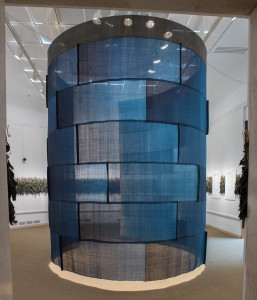
“Dreamy blues/Mood indigo.”
—Duke Ellington, 1931
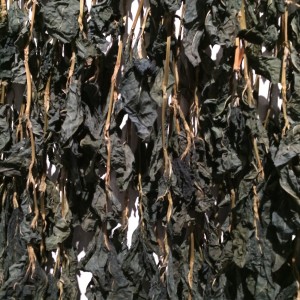
Breathe deeply as you enter the first gallery of “Mood Indigo, Textiles from Around the World,” then look carefully at the dried plants hanging on the walls. Now, enter a high enclosure of fabric dyed in many shades of blue and experience a constantly changing sound scape that evokes the sounds of color, and the color of sound. The collaborative contemporary installation Mobile Section, 2015, by textile artist Rowland Ricketts and sound artist Norbert Herber provides a perfect introduction to this highly original exhibition. It gives us the material qualities of the immaterial, color, created only by the refraction of light.
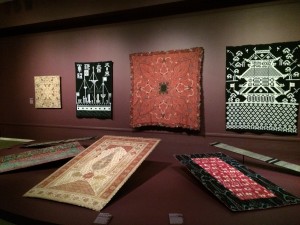
The first exhibition of textiles at the Seattle Art Museum since 1980, “Mood Indigo” features almost 100 different textiles and garments, many of them never before exhibited. While Pamela McClusky, Seattle Art Museum’s wonderful curator of Art of Africa and Oceania took the lead in the theme of the exhibition, she collaborated with the curators of Native American Art, Chinese Art, and Japanese Art, as well as, importantly, Nicholas Dorman, Conservator, and Paul Martinez, Installer, who solved the incredible challenges of installing flat textiles in a dynamic way.
Together they excavated the collections with an eye for indigo blue, a radical project.
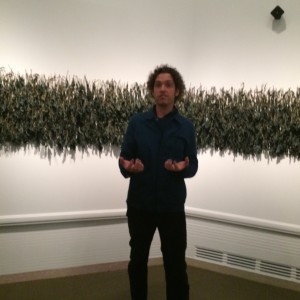
Indigo does not actually exist in the world. It must be produced from a molecule in one of about 20 plants (of which there are 600 varieties). Rowland Ricketts explained the process in detail. When the plants reach waist high, they are harvested, dried, stomped on, mixed with water, left 100 days in compost, turned, sliced, watered, and bagged. The resulting paste ferments in a vat with wood ash, lime, and wheat bran (everyone around the world has a different formula, often a family secret). During the oxidation/reduction process as it is stirred daily, the color appears, like magic. Vats themselves apparently have attributes and respond to the person stirring it. The color comes alive in different ways according your own mood!
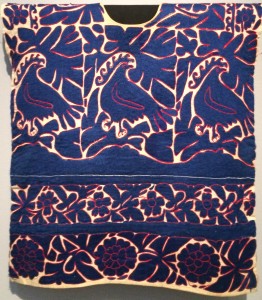
Guatemalan textile
Focusing on indigo textiles erases borders of geography and categories. Textiles here emerge from the margins established by European academic traditions that privileged painting and sculpture, and from the depths of storage at the Seattle Art Museum.
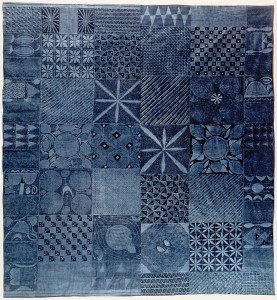
Adire Alabere Nigerian
The indigo textiles in this exhibition encompass all classes of society and all parts of our life. They cover us when we sleep and work, they ornament us for special events, they define rituals and ceremonies, they wrap us when we die. Indigo blue clothing signifies status and royalty, but it also covers the backs of peasants, prisoners (in the 1940s), and “blue collar” workers. The textiles contain secrets and symbols. The indigo blue suggests many emotions, sad, reflexive, humble or joyful.

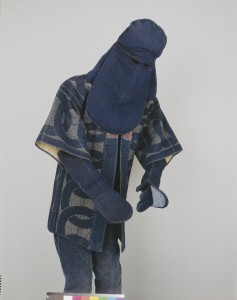
The exhibition ranges from ancient African fragments to a towering Basinjom (spirit) mask and gown, from an imperial Chinese robe to a Japanese fireman’s outfit. It includes a Guatemalan cape, a Peruvian feather quilt, a contemporary American textile created from denim jeans,
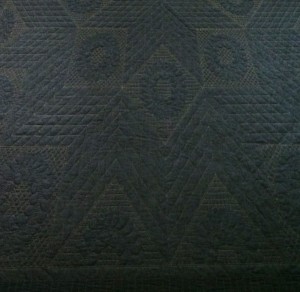
Anissa Mack Broken Star
a Tlingit basket, a Javanese head shawl, a Laotian shawl and a Korean Bojagis.
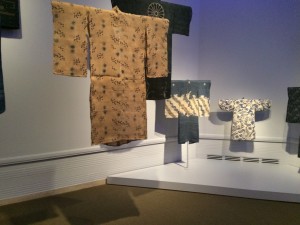
Japanese kimonos fill an entire gallery like fluttering butterflies.
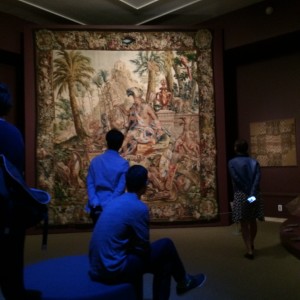
Colonial powers traded indigo in massive amounts, particularly from Bengal. Three huge Belgian tapestries made during the height of this trade anchor one gallery, each representing a different continent, Asia, America, and Africa. The allegorical royal figures seated at the center of the tapestries are dressed in blue fabrics, and they are surrounded by a wealth of symbols. Meticulously restored, the tapestries have never before been displayed by the Museum (they were a 1962 gift from the Hearst Foundation). Fascinating as they are to view, I felt that they recapitulated the oppressions of colonialism as they towered over clusters of tapestries from each continent. The egalitarianism of the exhibition was disrupted by their scale and their academic imagery, the three royal figures were all women draped in fabric that exposed their breasts.
The Belgian tapestries magnify the global scope of the exhibition, but the real joy of “Mood Indigo” is the range of cultures that it encompasses, and the many different directions that focusing on Indigo blue can take us. Curator Pamela McClusky even pointed out that in May we will have a blue moon (when there are two moons in one month).
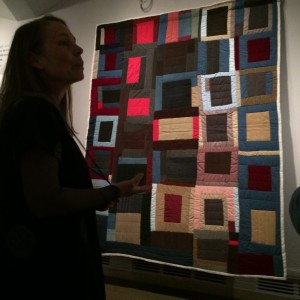
Annie Mae Young Gee’s Bend Quilt Blocks 2003
“The deeper blue becomes the more urgently it summons man toward the infinite, the more it arouses in him a longing for purity, and, ultimately, for the supersensual.”
—Wassily Kandinsky
at the Seattle Asian Art Museum
April 9 – October 9, 2016
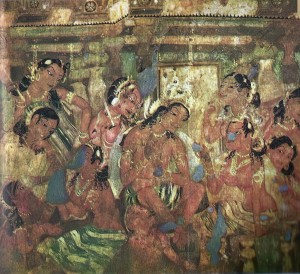
Ajanta Cave I detail
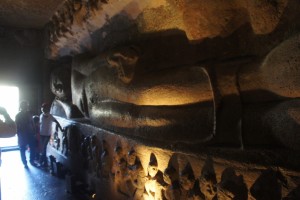
reclining Buddha Ajanta Caves India
“Journey to Dunhuang: Buddhist Art of the Silk Road Caves,” March 5 – June 12, 2016
While you are at the Asian Art Museum, visit the exhibition of photography and painting based on the Buddhist art in the thousands of caves of Dunhuang, a World Heritage site in Western China. Now in a desolate desert landscape, it formerly lay at the crossroads of several civilizations on the “Silk Road”. The exhibition intersperses historical photographs from the 1940s by James and Lucy Lo, and replicas that they commissioned in the 1950s of some of the ancient paintings. It provides an insight into an important phase of Buddhist art that lasted from the fourth century to the fourteenth century. Some of these painters may have travelled from Ajanta in India, where you see similar caves with early carvings of giant Buddhas and stories of the life of Buddha painted on walls and ceilings.
This entry was posted on May 5, 2016 and is filed under Textiles, Uncategorized.








